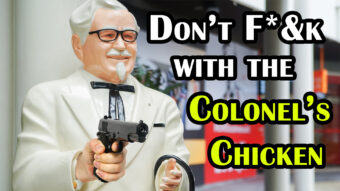 Born September 9, 1890 in Henryville, Indiana, Harland Sanders’ wasn’t exactly born with a silver spoon. His father passed away when he was six and his mother had to work several jobs to make ends meet. Because of this, he was tasked with looking after his two younger siblings and taking care of the home, which is where his passion and skill at cooking first began.
Born September 9, 1890 in Henryville, Indiana, Harland Sanders’ wasn’t exactly born with a silver spoon. His father passed away when he was six and his mother had to work several jobs to make ends meet. Because of this, he was tasked with looking after his two younger siblings and taking care of the home, which is where his passion and skill at cooking first began.
From here, needing to help provide for the family, he entered the workforce at the age of ten as a farmhand making two dollars (about $60 today) per month. At 15, he was working on a streetcar, taking fares and making change. When he was 16, he went looking for adventure and forged documents saying he was of age to enter the Army. He ultimately served for three months in Cuba before being honorably discharged.
After this, he made his way to Alabama and over the next twenty plus years worked at variety of jobs including railroad worker, insurance salesmen, country lawyer, Ohio River steamboat ferry operator, a tire salesman, fireman, and secretary to the Chamber of Commerce in Columbus, Indiana. At the end of this, for six years he was the operator of a gas station- his longest tenured job- before it was closed due to the Great Depression…
And so it was that in 1930, at the age of 40, broke, and having already failed several times in the workforce, he made his way to Corbin, Kentucky where the Shell Oil Company agreed to allow him and his family to live at a recently built gas station if he would help run it.
This brings us to the story of the hour- that time the Colonel got in a gun fight with a rival gas station worker resulting in the death of one of those involved.
So what happened? It all started with an advertising sign.
You see, the manager at the neighboring Standard Oil gas station, Matt Stewart, decided one day to paint over a nearby Shell advertising sign. This resulted in Sanders re-painting the sign… only to see Stewart paint over it again- this time in plain site of Sanders and two Shell district managers who were meeting with the Colonel at the time.
It was on.
As anyone would do upon witnessing such a dastardly deed, the trio grabbed their guns and headed out to confront Stewart.
A heated argument ensued with guns on both sides being pulled and the whole thing devolving into a firefight in which Sanders successfully shot Stewart, but not before one of the Shell managers, Robert Gibson, was himself shot and killed.
Luckily for Sanders and all of us who enjoy KFC, however, as Stewart had shot at the trio first, Sanders would get off scot-free. It was self-defense, you see… Despite, you know, the trio being the ones to approach the lone Stewart packing their guns.
And so it was that Stewart went to jail for murdering Gibson. His sentence was 18 years, but he died two years in, killed by a deputy sheriff, with rumors swirling that the sheriff had been paid by Gibson’s family to off Stewart, though the sheriff wasn’t charged with any crime here.
Moving back to the gas station, from here, Sanders ultimately got the bright idea of feeding the many motorists who would stop for gas and ask for recommendations on a good place to eat nearby. He started by serving them in his own dining room, but then expanded to opening a cafe. With this going well, he bought out the motel across the street and turned it into a 142-seat restaurant.
By 1935 business was booming and the governor of Kentucky, Ruby Laffon, officially bestowed Harland Sanders the title of “Colonel” “in recognition of his contributions to the state’s cuisine.” He would be commonly called “Colonel Sanders” from that point forward.
If you’re wondering, the honor of Kentucky Colonel began in 1813 and it started as a military role. After the War of 1812, Charles S. Todd was named a Kentucky Colonel so he would continue serve as a military liaison for the governor. By the late 19th century, it was more of a symbolic honor given to those chosen to “stand guard” at state functions and social events. And if you’re further wondering why “colonel” is pronounced “kernel”, well, you’re going to have to wait for the Bonus Facts later because right now we’re going back to the story of the most famous Kentucky Colonel.
You might think after receiving this honor and with business booming it would be easy street for the new Colonel here, but instead Sanders would soon have major trouble keeping his business afloat. To begin with, a fire in 1939 burned down the entire restaurant, but he rebuilt it. A year later, along with a new motor court, Sanders Court and Cafe was back on its feet and selling chicken like gangbusters to travelers making their way on US 25 – a major north/south route in America.
Unfortunately for him, in the early 1950s, a junction on route 25 was relocated, significantly reducing traffic by his restaurant, causing his business to go down the tubes. The final nail in the coffin was when the route of the new Interstate 70 was announced and it did not swing by Sanders Court and Café either, but rather routed everyone about 7 miles away.
And so it was that at the age of 62, the Colonel sold his restaurant and motor court, barely making enough to pay off his debts, and hit the road with his pressure cooker, hoping to convince others to use his recipes in their restaurants in exchange for a small commission.
His general method here was to go to a restaurant, cook his chicken, including demonstrating how to use the pressure cooker. If the owner liked what he made, he’d then try to convince them to let him make the chicken for customers.
Incidentally during this tour is when he first met a young Dave Thomas, future founder of the Wendy’s franchise who would eventually play an integral role in saving KFC when it was going down the tubes, before himself founding Wendys- more on this in the Bonus Facts in a bit.
Going back to the Colonel, sleeping in his car and broke again, he finally got one Pete Harmon, owner of the Do Drop Inn in Salt Lake City, Utah decided to make a deal to license his recipe and chicken making method.
With a handshake agreement in 1952, Salt Lake City became the first city with a Kentucky Fried Chicken franchise.
Within 7 years of this, Sanders had made over 200 such deals in the US and Canada.
Colonel Sanders was finally a permanent success and at the age of 74 in 1964 he decided to take it easy, selling the company for $2 million (about $16 million today) plus a salary of $40,000 per year (about $300,000 today) for the rest of his life in exchange for his staying on as the spokesman and the face of Kentucky Fried Chicken.
Unfortunately for him, as so often happens when a founder of a company sells or involves outside investors, he was quickly at odds with the board running KFC over their changing of recipes, often to save money. He particularly hated their so-called “Original Recipe” chicken, which he called “fried doughball stuck on some chicken”. He also didn’t care for the changes to the gravy recipe, noting, “My God, that gravy is horrible. They buy tap water for 15 to 20 cents a thousand gallons and then they mix it with flour and starch and end up with pure wallpaper paste.”
Company executives responded publicly stating, “Let’s face it, the Colonel’s gravy was fantastic but you had to be a Rhodes Scholar to cook it.”
This eventually culminated in him trying to separate himself from KFC by starting a new chicken restaurant. When KFC interfered with his new business, he sued them for $122 million. The lawsuit was eventually settled out of court with Sanders getting $1 million and allowed to continue to operate his new restaurant, which is still around today, called Claudia Sanders Dinner House, located in Shelbyville, Kentucky.
Despite his issues with management, he spent the rest of his life traveling, talking chicken, and giving surprise inspections to KFC franchise locations, until the day he died at age of 90 in 1980.
If you liked this article, you might also enjoy our new popular podcast, The BrainFood Show (iTunes, Spotify, Google Play Music, Feed), as well as:
Before we get into Dave Thomas’ fascinating story, let’s talk about why “Colonel” is pronounced “kernel” shall we?
“Colonel” ultimately derives from the Latin “columna,” meaning “pillar.” This gave rise to the Old Italian “compagna colonnella,” meaning “little-column company.” This, in turn, gave us the rank of “colonnello” -the leader of a column.
Other nations adopted this ranking giving us the Middle French “Coronel.” This was pronounced pretty much like it looks at first, then later slurred down to “Kernel” by the English, but using the same spelling.
However, starting with the French around the 1540s, the spelling was changed back closer to the Italian spelling, which gave us “Colonel” in French.
Within a few decades, the English also followed suit and by the mid-seventeenth century, “colonel” was the most common way to spell the word in English. At that time, the common pronunciation was mixed between the older “kernel” and the new “colonel,” with the former winning out in the end, despite the way it’s spelled.
Moving on from there, as alluded to, the founder of Wendy’s, Dave Thomas, actually once saved KFC and used it as his launching point to creating his own franchise, which today has almost 7000 locations. So how’d he do this?
Much like the Colonel, Thomas entered the work force quite young, first working at a Knoxville restaurant at the young age of 12 years old, from which he was eventually fired due to a misunderstanding with his boss about a vacation.
At 15, he worked part time at the Hobby House Restaurant in Ft. Wayne when his adoptive father and step-family (Thomas never met or knew who his biological parents were as his mother gave him up as a baby owing to the Great Depression) decided to move. Feeling ready to strike it out on his own, he decided to drop out of high school and stay in Ft. Wayne. He then moved into the YMCA and started working full time at the Hobby House.
While dropping out of high school to work at a restaurant most decidedly wouldn’t work out for most in terms of long term fame and fortune, it was through his job at the Hobby House Restaurant that Sanders would meet none other than Colonel Sanders himself, who later became Thomas’ mentor.
Many years later, after a stint in the Korean war as a cook in the army for which he volunteered, in 1962, Thomas used the money he earned there to invest in and was placed in a managerial position over four of Colonel Sanders’ KFC’s that were failing. He saw that one of the problems with KFC, and all fast food restaurants of the day, is that their menus were much too complicated.
He thus worked with Colonel Sanders to drastically simplify the menus at KFC, focusing on a few, select, signature meals.
It worked.
And soon business was booming and other fast food chains and restaurants quickly adopted the same approach, which is still common to this day. Not the last fast-food restaurant staple that Thomas would be responsible for, as we’ll get into momentarily.
But before that, we should also point out that Thomas was also the one who introduced the KFC trademark sign featuring a revolving red-striped bucket of chicken.
In any event, after he had turned these failing KFC restaurants around, he then sold his stake in them back to Colonel Sanders for a significant profit over what he originally paid, receiving $1.5 million in the sale (about $12 million today).
Rather than kicking back on a beach somewhere with a few scantily clad ladies and some margaritas for the rest of his life, Thomas instead took this money and ultimately opened the first “Wendy’s Old Fashioned Hamburgers” on November 15, 1969.
If you’re wondering here, the restaurant was named after his fourth child, Melinda Lou Thomas, who was nicknamed “Wendy” as in her formative years she pronounced her own name, Melinda, as “Wenda”.
Among the innovations Thomas would soon introduce at his restaurants were, among other things, being the first to successfully implement a drive through pickup in a restaurant, which is of course, now used by pretty much all fast food restaurants.
Wendy’s was also the first to successfully create a “fast food” style restaurant that didn’t pre-cook its food nor used pre-made frozen items. He credits his ability to do this with knowledge gained in cooking for over 2000 soldiers daily while in the army.
Upon his death in 2002 of cancer, there were over 6000 Wendy’s restaurants across the world, and today, there are close to 7000, some of which are actually still owned and run by the original Wendy (Melinda Thomas) herself, along with her three sisters.
And incidentally, realizing that his later success as a high school dropout might convince other teenagers it was ok to quit school, in the early 1990s at the age of 61, Thomas became a student at Coconut Creek High School, ultimately earning his G.E.D. Along the way, he was voted by his classmates as “most likely to succeed.” Nailed it.



 Anyone who has seen Mad Men knows that the 1960s in America were a time of unmitigated consumerism. Advertising was largely unregulated—a fact that continues to influence certain industries. Nowhere is this more apparent than in the cereal aisle. Several mainstays of the canonically fuzzy cereal multiverse have their origins in the Wild West period of children’s marketing: Lucky the Leprechaun, Toucan Sam, and, of course, the infamous, mouth-mutilating Cap’n Crunch. While he may seem like any other innocent mascot, Cap’n Horatio Magellan Crunch is a man of mystery and intrigue. He has been subject to U.S. naval investigation, helped give the world the iPhone, and his dog may be implicated for manslaughter.
Anyone who has seen Mad Men knows that the 1960s in America were a time of unmitigated consumerism. Advertising was largely unregulated—a fact that continues to influence certain industries. Nowhere is this more apparent than in the cereal aisle. Several mainstays of the canonically fuzzy cereal multiverse have their origins in the Wild West period of children’s marketing: Lucky the Leprechaun, Toucan Sam, and, of course, the infamous, mouth-mutilating Cap’n Crunch. While he may seem like any other innocent mascot, Cap’n Horatio Magellan Crunch is a man of mystery and intrigue. He has been subject to U.S. naval investigation, helped give the world the iPhone, and his dog may be implicated for manslaughter. Born September 9, 1890 in Henryville, Indiana, Harland Sanders’ wasn’t exactly born with a silver spoon. His father passed away when he was six and his mother had to work several jobs to make ends meet. Because of this, he was tasked with looking after his two younger siblings and taking care of the home, which is where his passion and skill at cooking first began.
Born September 9, 1890 in Henryville, Indiana, Harland Sanders’ wasn’t exactly born with a silver spoon. His father passed away when he was six and his mother had to work several jobs to make ends meet. Because of this, he was tasked with looking after his two younger siblings and taking care of the home, which is where his passion and skill at cooking first began. In the pantheon of iconic aircraft, perhaps none is more revered than the Supermarine Spitfire. Considered one of the most beautiful fighters ever designed, along with its stablemate the Hawker Hurricane the Spitfire has become emblematic of Britain’s determined resistance against Nazi Germany in the early days of the Second World War. Yet despite its legendary reputation, the Spitfire was far from a perfect machine. Its narrow landing gear made landings precarious, its widely-spaced wing-mounted guns reduced its concentration of firepower, and at higher speeds its elegant elliptical wings had a tendency of flexing, often leading to fatal crashes. But the Spitfire’s greatest achilles heel lay in a component almost as celebrated as the aircraft itself: its Rolls-Royce Merlin engine.
In the pantheon of iconic aircraft, perhaps none is more revered than the Supermarine Spitfire. Considered one of the most beautiful fighters ever designed, along with its stablemate the Hawker Hurricane the Spitfire has become emblematic of Britain’s determined resistance against Nazi Germany in the early days of the Second World War. Yet despite its legendary reputation, the Spitfire was far from a perfect machine. Its narrow landing gear made landings precarious, its widely-spaced wing-mounted guns reduced its concentration of firepower, and at higher speeds its elegant elliptical wings had a tendency of flexing, often leading to fatal crashes. But the Spitfire’s greatest achilles heel lay in a component almost as celebrated as the aircraft itself: its Rolls-Royce Merlin engine. On February 27, 1942, a strike force of British, Australian, American, and Dutch ships clashed with an Imperial Japanese Navy Cruiser squadron off the coast of Sumatra. The engagement, known as the Battle of the Java Sea, was a decisive victory for the Japanese, resulting in the loss of 2,300 Allied sailors and 5 ships, including the light cruiser HMS Exeter. 65 years after the battle, a team of exploration divers re-discovered the wreck sitting in 200 feet of water 90 miles north-west of Bawean Island. But when another team surveyed the wreck site 10 years later, they made a shocking discovery: the wreck had completely vanished, leaving only a 500-foot-long depression in the seabed. The disappearance was not the work of supernatural forces but of Indonesian illegal salvagers, who armed with nothing more than small boats and air compressors had managed to strip away the nearly 10,000 ton hull in less than a decade. While warships contain huge quantities of bronze, brass, copper, and other non-ferrous metals that can fetch high prices on the scrap market, the complete disappearance of Exeter’s entire hull was baffling, leading some to speculate that it had been harvested for the little-known but highly lucrative market for low-background steel. But was it really and how did this bizarre demand for battleship steel come to be?
On February 27, 1942, a strike force of British, Australian, American, and Dutch ships clashed with an Imperial Japanese Navy Cruiser squadron off the coast of Sumatra. The engagement, known as the Battle of the Java Sea, was a decisive victory for the Japanese, resulting in the loss of 2,300 Allied sailors and 5 ships, including the light cruiser HMS Exeter. 65 years after the battle, a team of exploration divers re-discovered the wreck sitting in 200 feet of water 90 miles north-west of Bawean Island. But when another team surveyed the wreck site 10 years later, they made a shocking discovery: the wreck had completely vanished, leaving only a 500-foot-long depression in the seabed. The disappearance was not the work of supernatural forces but of Indonesian illegal salvagers, who armed with nothing more than small boats and air compressors had managed to strip away the nearly 10,000 ton hull in less than a decade. While warships contain huge quantities of bronze, brass, copper, and other non-ferrous metals that can fetch high prices on the scrap market, the complete disappearance of Exeter’s entire hull was baffling, leading some to speculate that it had been harvested for the little-known but highly lucrative market for low-background steel. But was it really and how did this bizarre demand for battleship steel come to be? In this episode of The Brain Food Show, we are start out with an appetizer looking at how chopsticks came to be and why they became so popular in certain parts of the world vs things like spoons and forks.
In this episode of The Brain Food Show, we are start out with an appetizer looking at how chopsticks came to be and why they became so popular in certain parts of the world vs things like spoons and forks.